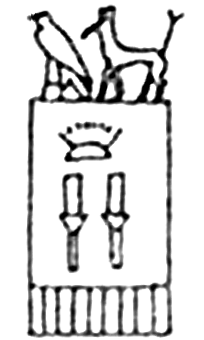Sun-rising (hieroglyph)
| ||
| Rising Sun (Coronation of King, Pharaoh) in hieroglyphs |
|---|
| |||||||
| Rising Sun (variations-Khā) in hieroglyphs |
|---|
The ancient Egyptian "Rising sun" hieroglyph is one of the oldest language hieroglyphs from Ancient Egypt. It was used by Pharaoh Khasekhemwy-( 'Khā-sekhem' ) of the 2nd dynasty in composing his name. The hieroglyph is also used to represent: "Coronation", and its basic meaning related to festivals, parades, rejoicing, etc., and the sun arising each day is: "rejoice".
Language usage of "Rising sun"-(Khā)

Serekh, using the Horus–falcon, and the Set-animal (hieroglyph).
(for his name: rising sun: Kha + sekhemwy.
The basic usage of the Rising sun symbol is as the language equivalent: "khā", and is used to refer to "risings", "splendours", "coronations"; also the related word "crowns". The alternate hieroglyphic spelling with the sieve (hieroglyph) shows its other language variety, in a Composite hieroglyph block word.
Rosetta Stone usage
Line 11 of the Rosetta Stone refers to an event, one of the ten ways that the honoring of Pharaoh Ptolemy V is to be done:
- "There shall be celebrated a festival and 'a day of rejoicing'-(Khā), in the temples of Egypt, all of them, of the King of the South and the North, Ptolemy, the everliving, of Ptah, beloved, the god appearing-(epiphanous), lord of benefits-(eucharistos-Greek), yearly, beginning in..."[1]
In the Rosetta Stone, the second half of the decree, the Decree of Memphis (Ptolemy V), the Rising Sun (hieroglyph) is used six times, in lines: R-4, 7, 10-(twice), 11, and 13; all uses are related to either festivals, or erecting/constructing a statue.
See also
References
- ↑ Budge, The Rosetta Stone, p. 165.
- Budge. The Rosetta Stone, E.A.Wallace Budge, (Dover Publications), c 1929, Dover edition(unabridged), 1989. (softcover, ISBN 0-486-26163-8)
| Wikimedia Commons has media related to Sunrise (hieroglyph). |